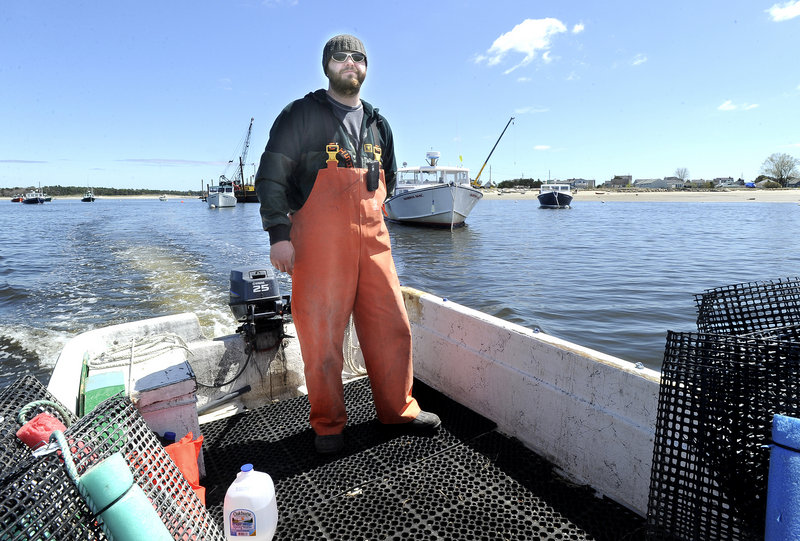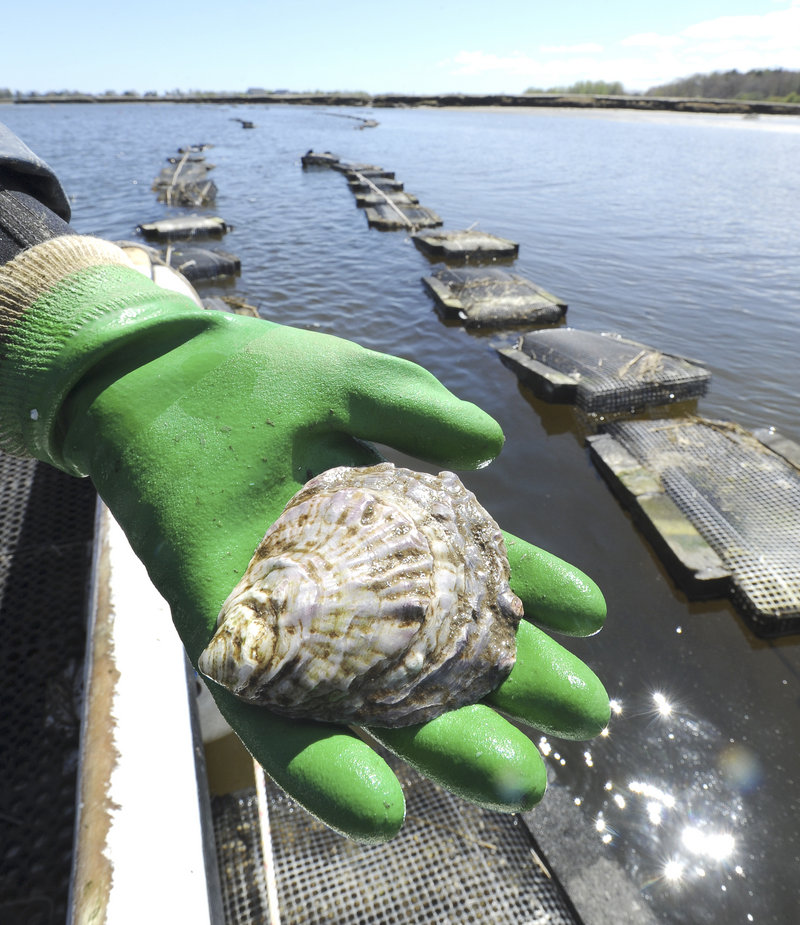SCARBOROUGH – Standing on his pontoon workstation, Nate Perry scooped young inch-and-a-half-long oysters into plastic mesh bags. Good weather meant an opportunity to deploy some floating bags and get the shellfish on the way to market size.
By this time of year, nearly all the bags have been set out. The warm waters of the Scarborough River will encourage the oysters to pump and take in nutrients after their winter hibernation. When they reach cocktail size — 3 inches — Perry, a one-man operation, will be able to harvest them and sell them to markets and restaurants hungry for Maine oysters.
Perry and Abigail Carroll, another fledgling farmer, are among the first to try oyster aquaculture in the Scarborough River. The location, with its tidal currents and particular nutrients, creates oysters that they try to describe with such adjectives as briny, sweet, creamy and grassy.
“That’s what an oyster is — it’s the taste of the sea where it came from,” Perry said.
While Carroll sees continued high demand for Maine oysters, she cautions that oyster aquaculture isn’t for everyone. The work, she notes, is dirty, hard and very physical.
Carroll and Perry each use bags with foam floats that are connected to lines. The systems vary in the details, and Carroll and her two part-time employees do some of their work on the beach at low tide rather than on a pontoon like Perry does.
But each of them will have to flip the bags regularly to dry out the algae that forms on the wet side and root out invaders such as starfish and crabs. As the oysters grow, the farmers have to sort them into different bags to provide them more room.
“You’ve got to really nurture these guys,” Carroll said.
It takes about three years to grow oyster seeds — specks about 2 millimeters big — to market size. Carroll got a jump start with her initial batch by starting with juveniles.
Perry and Carroll each are looking to expand small operations around Nonesuch Point after an initial go under small-scale licenses that limit operations to 400 square feet. Under the new licenses they’re seeking, Perry could expand to 1.4 acres and Carroll to 4 acres.
A third license holder, Ernest Heether, began a venture with Carroll before they went their separate ways. Heether, who could not be reached, has renewed his small-scale license with the state.
The expansions planned by Perry and Carroll come at time when aquaculture is becoming the new face of the working waterfront in Maine, said Sebastian Belle, executive director of the Maine Aquaculture Association. The sector is growing as it becomes more difficult to make a living in traditional fishing, whether because of limits on the resources or a lack of available licenses, he said.
Perry, who comes from a lobstering family, also makes his living by teaching music and working at J’s Oyster in Portland. (His shucking skills — he’s done about 1,000 in an hour — once won him a state title.) Carroll is an entrepreneur who got immersed in oyster aquaculture after deciding to investigate the concept and work on a business plan.
Oyster aquaculture in Maine is centered on the Damariscotta River, where research at the University of Maine’s Darling Marine Center in South Bristol and warm water create a hospitable environment. More than 72 percent of last year’s harvest — some 2.96 million oysters — were from the Damariscotta River.
Interest in oyster aquaculture has been increasing slowly and steadily, said Jon Lewis, aquaculture environmental coordinator at the state Department of Marine Resources. There are about 150 oyster sites in the state, with some businesses operating multiple sites.
In addition to proper temperatures, oysters need areas that are free from fecal coliform contamination. Other considerations include navigation, water flow and other uses of the area.
Both Perry and Carroll are growing American, or Eastern, oysters, which account for nearly all the oysters from Maine. Wellfleets, bluepoints and Pemaquids are all American oysters that come from different locations.
Perry expects to sell his oysters under the name Pine Point Oyster Co. in time for Independence Day, and Carroll has been selling hers as Nonesuch Oysters.
He hopes to sell about 1,000 a week, while she hopes to increase production from hundreds a week to thousands.
As a side project, Carroll is also growing Belons, or European flats, the other type of oyster found in Maine. Distinctive in their metallic undertones, Belons are prized in their homeland of France and among connoisseurs. They are also more difficult to grow. Carroll is growing them as part of a research project coordinated by the Downeast Institute for Applied Marine Research and Education.
Oysters are a high-value product, with American oysters able to fetch 50 or 60 cents apiece on the wholesale market, according to Lewis. That market was worth more than $1.75 million last year.
The strength of Maine’s brand is based not just on the state’s reputation as a pristine area. There’s a biological basis as well, Belle noted.
Water temperatures in Maine are relatively cold, which means that oysters here generally do not spawn. When oysters direct their energies toward reproduction, their glycogen content falls, making them less sweet and plump, Belle said.
Maine oyster farmers cannot grow enough to satisfy demand, and it’s not uncommon for growers to have to ration the number they provide to each account, Belle said.
“There aren’t enough Maine oysters for the world,” Carroll said.
Staff Writer Ann S. Kim can be
contacted at 791-6383 or at:
akim@pressherald.com
Send questions/comments to the editors.








Success. Please wait for the page to reload. If the page does not reload within 5 seconds, please refresh the page.
Enter your email and password to access comments.
Hi, to comment on stories you must . This profile is in addition to your subscription and website login.
Already have a commenting profile? .
Invalid username/password.
Please check your email to confirm and complete your registration.
Only subscribers are eligible to post comments. Please subscribe or login first for digital access. Here’s why.
Use the form below to reset your password. When you've submitted your account email, we will send an email with a reset code.